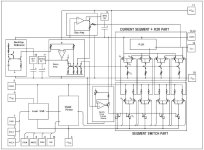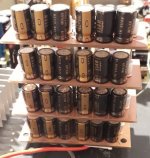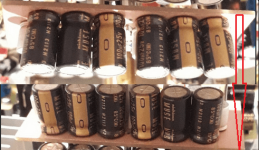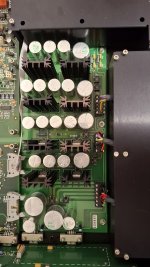My WADIA 27 (no I, or Ix version) as build 1996 needs some repair, as one channel only shows on certain -FFH to -100H (may multiple of) data ugly glitches.
As used capacitors are electrolyte and most on the DAC chips as Tantalum. I have no idea what brand or company produced those about 30 years ago.
Many suggests electrolyte for the DAC de-compelling but WADIA used Tantalum see picture.
But WADIA used those black 47u/10V. To replace those with electrolyte will shows a height issue, as for 2 of them as maximal 14mm while the PCB's are opposite stacked/mounted.
See attached the culprit and glitches may relate to certain over-sampled DAC only.
So the question is, what Tantalum may work & accepted by the PCM1702/04 for de-compelling.
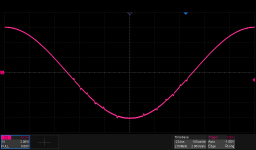
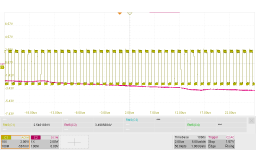
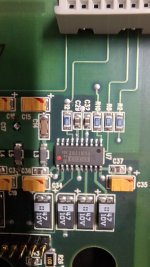
As used capacitors are electrolyte and most on the DAC chips as Tantalum. I have no idea what brand or company produced those about 30 years ago.
Many suggests electrolyte for the DAC de-compelling but WADIA used Tantalum see picture.
But WADIA used those black 47u/10V. To replace those with electrolyte will shows a height issue, as for 2 of them as maximal 14mm while the PCB's are opposite stacked/mounted.
See attached the culprit and glitches may relate to certain over-sampled DAC only.
So the question is, what Tantalum may work & accepted by the PCM1702/04 for de-compelling.



Those are not standard series tantalum caps. I have those in 100 uF. I think they were called Poscap!?
Why use normal caps? In 30 years tantalum caps have improved a lot.
Why use normal caps? In 30 years tantalum caps have improved a lot.
Last edited:
As I have written, electrolyte will not work, as two between two PCB no more than 14mm in separations.
As it goes with this two opposite stacked PCB's, not chance to measure as terrible serviceable. May only PNP until it works again O😉.
So I really need tantalum's.
Yes, I do not know about the lower ESR & PCM170x DAC's. Any information available about what is accepted?
Attached the internal drawing of the DAC.
As it goes with this two opposite stacked PCB's, not chance to measure as terrible serviceable. May only PNP until it works again O😉.
So I really need tantalum's.
> In 30 years tantalum caps have improved a lot.
Yes, I do not know about the lower ESR & PCM170x DAC's. Any information available about what is accepted?
Attached the internal drawing of the DAC.
Attachments
Conductive Polymer Tantalum Solid Capacitors (POSCAP) of Panasonic
https://industrial.panasonic.com/ww/products/pt/poscap 2000h at 105C 😡 and not that cheap O😉Have many of them but way more recent and 100 uF 6.3V.
My favorites are AVX TPS series. I make sure to overrate them twice the working voltage at least. Old habits….
Never had a single defective one of those.
I would check if todays 35V rated ones fit for the 20V ones and 16V versions for the 10V rated ones. All in the same capacitance as before.
My favorites are AVX TPS series. I make sure to overrate them twice the working voltage at least. Old habits….
Never had a single defective one of those.
I would check if todays 35V rated ones fit for the 20V ones and 16V versions for the 10V rated ones. All in the same capacitance as before.
Last edited:
Yes, for the +/- 5V power, similar as yellow are used as AVX, KEMET.
For the internal VRef or Servos, on those is the audio signal to have for sure low ESR over freq.
As those are internal LDO's or shunt regulators and may sensitive to low ESR or high leakage current
what could cause the singing or oscillations.
I measured on the current tantalum 47u/10V more or less no leakage.
As it goes as with AKM/ESS audio ADC/DAC's, no any specifications nor any information given about the VRef current f (freq) as
often internal caps switching loads.
For the internal VRef or Servos, on those is the audio signal to have for sure low ESR over freq.
As those are internal LDO's or shunt regulators and may sensitive to low ESR or high leakage current
what could cause the singing or oscillations.
I measured on the current tantalum 47u/10V more or less no leakage.
As it goes as with AKM/ESS audio ADC/DAC's, no any specifications nor any information given about the VRef current f (freq) as
often internal caps switching loads.
The black capacitors are SANYO POSCAP (Polymer Tantalum) and have a slightly higher leakage current like all polymers. Vishay TL3 or KEMET T489 which have a lower leakage current would be better in that position.
I don't believe that the problem is with them because they are good caps, but you never know. The problem could be in the power supply(regulators) itself or in I/V stage .
In my DAC with eight PCM1702 in that position Nichicon UKZ proved to be the best and OS-CON for decoupling.
I don't believe that the problem is with them because they are good caps, but you never know. The problem could be in the power supply(regulators) itself or in I/V stage .
In my DAC with eight PCM1702 in that position Nichicon UKZ proved to be the best and OS-CON for decoupling.
I know that BG are better but my household stock has long since dried up and UKZ is no longer produced 🙁 .
Try Panasonic FMI know that BG are better but my household stock has long since dried up and UKZ is no longer produced 🙁 .
That is much easier 'to say' than 'to do' 🙂 .
Otherwise, I am satisfied with the sound of the OS-CON and UKZ combination. UKZ 100uF/25V turned out to be really excellent (not all UKZ), I use it in all Walt Jung regulators (on his recommendation).
Otherwise, I am satisfied with the sound of the OS-CON and UKZ combination. UKZ 100uF/25V turned out to be really excellent (not all UKZ), I use it in all Walt Jung regulators (on his recommendation).
Attachments
Last edited:
The black capacitors are SANYO POSCAP (Polymer Tantalum) and have a slightly higher leakage current like all polymers. Vishay TL3 or KEMET T489 which have a lower leakage current would be better in that position.
I don't believe that the problem is with them because they are good caps, but you never know. The problem could be in the power supply(regulators) itself or in I/V stage .
In my DAC with eight PCM1702 in that position Nichicon UKZ proved to be the best and OS-CON for decoupling.
My issue with this WADIA 27 is, the maximal height with 2 caps, as mentioned, is 14mm so to use tantalum's!
The Kemet and Yishay (Sprague) looks promising, As lower leakage.
> I don't believe that the problem is with them because they are good caps
The real point is this, they are now 30 years old and the WADIA 27 as by default, do not have a power switch.
It is as a repeated data FF hex to 100 hex step level issue. It could be a DSP sample related, Chip related or power use related issue.
The WADIA 27 is at over sample rate of 2.8Mhz, as 4 DAC's timely stacked using 768kHz and using a SPLINE algorithm and beats all my SDM DAC?s sound wise. Also tweaked as all cap's without plastic closes, as pans off 😀
That's why I am looking to fix it. May need to test with a logic analyzer whether the left & right samples are equal.
Attachments
No power switch and built in 1996 possibly means that the device is EOL. My experience with very old always on stuff is that it all performs good until the power is cut a few times. In my professional environment I deal with excellent always on linear power supplies that outperform and outlive all their recent brothers but all is good until a power cut. Everything has a lifetime and always on consumer stuff of 1996 is simply ready for recycling.
So maybe it is time to adapt to very modern DAC technology and enjoy the benefits. Surely there must have been development in the past decades that may suit you. The ES9039Q2M perhaps? AK4493SEQ? Or try the odd FN1242A Fluency DAC as it is special, hard to find and mysterious.
You could add an old SPDIF receiver like CS8412 to a recent DAC chip to equal the 250 ps of jitter of the Wadia 😉
So maybe it is time to adapt to very modern DAC technology and enjoy the benefits. Surely there must have been development in the past decades that may suit you. The ES9039Q2M perhaps? AK4493SEQ? Or try the odd FN1242A Fluency DAC as it is special, hard to find and mysterious.
You could add an old SPDIF receiver like CS8412 to a recent DAC chip to equal the 250 ps of jitter of the Wadia 😉
Last edited:
Lock, I do not get the harsh sound as from transistor or AKM/ESS gear. While switched to tube stuff as for me
with Magnepan getting more real beef. As it is as always a personal taste...
The WADIA & CS8412 with default filter (what needs anyway some tuning) and fiber links as best results with following a voltage controlled TXCO's. All passes to a FPGA (jittery) to drive the DAC's.
I do not understand, why no any spline related oversampling gear seen, even with new discrete R-2-R dac's what made the FIR a no go.
with Magnepan getting more real beef. As it is as always a personal taste...
The WADIA & CS8412 with default filter (what needs anyway some tuning) and fiber links as best results with following a voltage controlled TXCO's. All passes to a FPGA (jittery) to drive the DAC's.
I do not understand, why no any spline related oversampling gear seen, even with new discrete R-2-R dac's what made the FIR a no go.
I don't know and what I know is that some things do not correlate with numbers or prices. Last time a 100 Euro device outperformed such a feature rich expensive but harsh DAC. My Eversolo DMP-A6 is a fantastic device but its ES9038Q2M DACs (and I have heard/had other 9038 devices) are a step back. Who would have thought that? I have SD DACs that have no harsh sound whatsoever but I am not tube person so neutral it should be.
A source with decent built in DACs might be the thing to write on a shopping list 🙂 No interface = no interface issues. CS8412 is a joke compared to today's technology. Just cut out the middle man. I am afraid replacing the caps will not be the definitive repair.
A source with decent built in DACs might be the thing to write on a shopping list 🙂 No interface = no interface issues. CS8412 is a joke compared to today's technology. Just cut out the middle man. I am afraid replacing the caps will not be the definitive repair.
Last edited:
Those are not standard series tantalum caps. I have those in 100 uF. I think they were called Poscap!?
Why use normal caps? In 30 years tantalum caps have improved a lot.
Hi, have you some ref you liked more, please ? CD 490A ?
At least the PCM1702 sounded nice in the Denons & Wadia, but indeed, newest front end and USB asynchronous that reclock sound more fine than a CS8412 whatever it is crystal slaved, I am not sure it is only about the jitter only btw !
Off topic but I do not care much for comparing electrolytic/tantalum caps anymore. If they are OK and give no trouble I am satisfied. My opinion is that the key is to use just enough of them 🙂 So simple circuits, no thrills and only the necessary for reproducing 2 channel audio. It is a habit. The less there is the less can go wrong.
If a device suffers from electrolytic cap differences then there maybe is something not OK in the design. Many change caps and opamps because it is easy and it is also easy to think the actions matter.
If a device suffers from electrolytic cap differences then there maybe is something not OK in the design. Many change caps and opamps because it is easy and it is also easy to think the actions matter.
Last edited:
- Home
- Source & Line
- Digital Line Level
- PCM1702/1704 Capacitors renewing
